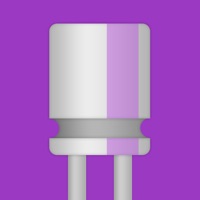
에 의해 게시 Nitrio
1. This charging (storage) and discharging (release) of a capacitor's energy are never instant but take a certain amount of time to occur, with the time taken for the capacitor to charge or discharge to within a certain percentage of its maximum supply value being known as its time constant (τ).
2. The time constant is a measurement of the time needed to charge a capacitor by approximately 63.2% or discharge a capacitor by about 36.8% of the difference between the old value and the new value after an impulse that induces a change has been applied.
3. This delay is generally known as the time delay or time constant of the circuit, and it is the time response of the circuit when a step voltage or signal is firstly applied.
4. The resultant time constant of any electronic circuit or system will mainly depend upon the reactive components, either capacitive or inductive, connected to it and is a measurement of the response time with units of Tau – τ.
5. The time constant also defines the response of the circuit to a step (or constant) voltage input.
6. - Energy stored on a capacitor (E) can be determined by providing all three inputs: voltage (V), capacitance (C), and load resistance (R).
7. - Time constant (T) can be determined from the values of capacitance (C) and load resistance (R).
8. When an increasing DC voltage is applied to a discharged capacitor, the capacitor draws a charging current and "charges up." When the voltage is reduced, the capacitor discharges in the opposite direction.
9. Consequently, the cutoff frequency of the circuit is defined by the time constant.
10. All electrical or electronic circuits or systems suffer from some form of “time-delay” between their input and output when a signal or voltage, either continuous (DC) or alternating (AC), is firstly applied to it.
11. Because capacitors are able to store electrical energy, they act like small batteries and can store or release the energy as required.
또는 아래 가이드를 따라 PC에서 사용하십시오. :
PC 버전 선택:
소프트웨어 설치 요구 사항:
직접 다운로드 가능합니다. 아래 다운로드 :
설치 한 에뮬레이터 애플리케이션을 열고 검색 창을 찾으십시오. 일단 찾았 으면 Capacitor Calculator 검색 막대에서 검색을 누릅니다. 클릭 Capacitor Calculator응용 프로그램 아이콘. 의 창 Capacitor Calculator Play 스토어 또는 앱 스토어의 스토어가 열리면 에뮬레이터 애플리케이션에 스토어가 표시됩니다. Install 버튼을 누르면 iPhone 또는 Android 기기 에서처럼 애플리케이션이 다운로드되기 시작합니다. 이제 우리는 모두 끝났습니다.
"모든 앱 "아이콘이 표시됩니다.
클릭하면 설치된 모든 응용 프로그램이 포함 된 페이지로 이동합니다.
당신은 아이콘을 클릭하십시오. 그것을 클릭하고 응용 프로그램 사용을 시작하십시오.
다운로드 Capacitor Calculator Mac OS의 경우 (Apple)
| 다운로드 | 개발자 | 리뷰 | 평점 |
|---|---|---|---|
| $2.99 Mac OS의 경우 | Nitrio | 2 | 5.00 |
Capacitor Charge and Time Constant Calculator The time constant is a measurement of the time needed to charge a capacitor by approximately 63.2% or discharge a capacitor by about 36.8% of the difference between the old value and the new value after an impulse that induces a change has been applied. The time constant also defines the response of the circuit to a step (or constant) voltage input. Consequently, the cutoff frequency of the circuit is defined by the time constant. Time Constant = Voltage (V) x Capacitance (μF) x Load Resistance (Ω) To calculate the energy (E) and time constant (RC) in a capacitor for the given voltage across it, we need two different values from the calculator: - Energy stored on a capacitor (E) can be determined by providing all three inputs: voltage (V), capacitance (C), and load resistance (R). - Time constant (T) can be determined from the values of capacitance (C) and load resistance (R). All electrical or electronic circuits or systems suffer from some form of “time-delay” between their input and output when a signal or voltage, either continuous (DC) or alternating (AC), is firstly applied to it. This delay is generally known as the time delay or time constant of the circuit, and it is the time response of the circuit when a step voltage or signal is firstly applied. The resultant time constant of any electronic circuit or system will mainly depend upon the reactive components, either capacitive or inductive, connected to it and is a measurement of the response time with units of Tau – τ. When an increasing DC voltage is applied to a discharged capacitor, the capacitor draws a charging current and "charges up." When the voltage is reduced, the capacitor discharges in the opposite direction. Because capacitors are able to store electrical energy, they act like small batteries and can store or release the energy as required. The charge on the plates of the capacitor is given as: Q = CV. This charging (storage) and discharging (release) of a capacitor's energy are never instant but take a certain amount of time to occur, with the time taken for the capacitor to charge or discharge to within a certain percentage of its maximum supply value being known as its time constant (τ). Thanks for your support, and do visit nitrio.com for more apps for your iOS devices.
Google Chrome

네이버 MYBOX - 네이버 클라우드의 새 이름
유니콘 HTTPS(Unicorn HTTPS)
T전화
Samsung Galaxy Buds

Google Authenticator
앱프리 TouchEn Appfree
전광판 - LED전광판 · 전광판어플
Samsung Galaxy Watch (Gear S)
Fonts
Whale - 네이버 웨일 브라우저
네이버 스마트보드 - Naver Smartboard
Pi Browser
더치트 - 사기피해 정보공유 공식 앱